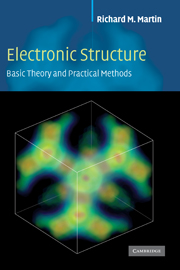Book contents
- Frontmatter
- Contents
- Preface
- Acknowledgments
- Notation
- Part I Overview and background topics
- Part II Density functional theory
- 6 Density functional theory: foundations
- 7 The Kohn–Sham auxiliary system
- 8 Functionals for exchange and correlation
- 9 Solving Kohn–Sham equations
- Part III Important preliminaries on atoms
- Part IV Determination of electronic structure: the three basic methods
- Part V Predicting properties of matter from electronic structure – recent developments
- Appendix A Functional equations
- Appendix B LSDA and GGA functionals
- Appendix C Adiabatic approximation
- Appendix D Response functions and Green's functions
- Appendix E Dielectric functions and optical properties
- Appendix F Coulomb interactions in extended systems
- Appendix G Stress from electronic structure
- Appendix H Energy and stress densities
- Appendix I Alternative force expressions
- Appendix J Scattering and phase shifts
- Appendix K Useful relations and formulas
- Appendix L Numerical methods
- Appendix M Iterative methods in electronic structure
- Appendix N Code for empirical pseudopotential and tight-binding
- Appendix O Units and conversion factors
- References
- Index
6 - Density functional theory: foundations
from Part II - Density functional theory
Published online by Cambridge University Press: 05 June 2012
- Frontmatter
- Contents
- Preface
- Acknowledgments
- Notation
- Part I Overview and background topics
- Part II Density functional theory
- 6 Density functional theory: foundations
- 7 The Kohn–Sham auxiliary system
- 8 Functionals for exchange and correlation
- 9 Solving Kohn–Sham equations
- Part III Important preliminaries on atoms
- Part IV Determination of electronic structure: the three basic methods
- Part V Predicting properties of matter from electronic structure – recent developments
- Appendix A Functional equations
- Appendix B LSDA and GGA functionals
- Appendix C Adiabatic approximation
- Appendix D Response functions and Green's functions
- Appendix E Dielectric functions and optical properties
- Appendix F Coulomb interactions in extended systems
- Appendix G Stress from electronic structure
- Appendix H Energy and stress densities
- Appendix I Alternative force expressions
- Appendix J Scattering and phase shifts
- Appendix K Useful relations and formulas
- Appendix L Numerical methods
- Appendix M Iterative methods in electronic structure
- Appendix N Code for empirical pseudopotential and tight-binding
- Appendix O Units and conversion factors
- References
- Index
Summary
E Pluribus Unum
Summary
The fundamental tenet of density functional theory is that any property of a system of many interacting particles can be viewed as a functional of the ground state density n0(r); that is, one scalar function of position n0(r), in principle, determines all the information in the many-body wavefunctions for the ground state and all excited states. The existence proofs for such functionals, given in the original works of Hohenberg and Kohn and of Mermin, are disarmingly simple. However, they provide no guidance whatsoever for constructing the functionals, and no exact functionals are known for any system of more than one electron. Density functional theory (DFT)would remain a minor curiosity today if it were not for the ansatz made by Kohn and Sham, which has provided a way to make useful, approximate ground state functionals for real systems of many electrons. The subject of this chapter is density functional theory as a methodology for many-body systems; Ch. 7 describes the Kohn–Sham ansatz that replaces the interacting problem with an auxiliary independent-particle problem with all many-body effects included in an exchange–correlation functional; Ch. 8 deals with widely used approximations for the exchange–correlation functional; and Ch. 9 is devoted to solution of the Kohn–Sham independent-particle equations in a general form useful for all Kohn–Sham calculations. Following chapters in this volume are devoted to algorithms for actual calculations, and applications to problems in atomic, molecular, and condensed matter physics.
- Type
- Chapter
- Information
- Electronic StructureBasic Theory and Practical Methods, pp. 119 - 134Publisher: Cambridge University PressPrint publication year: 2004
- 6
- Cited by



